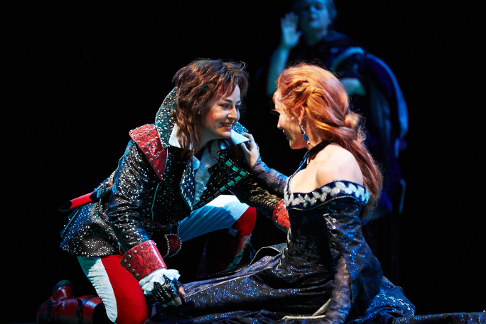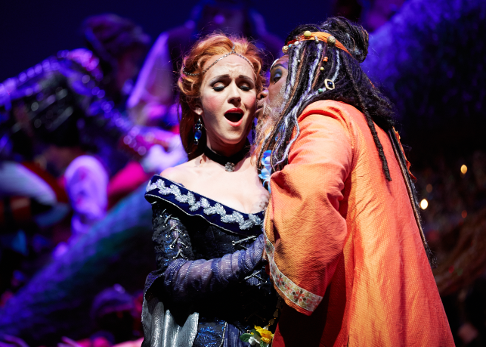Recently in Performances
English Touring Opera are delighted to announce a season of lyric monodramas to tour nationally from October to December. The season features music for solo singer and piano by Argento, Britten, Tippett and Shostakovich with a bold and inventive approach to making opera during social distancing.
This tenth of ten Live from London concerts was in fact a recorded live performance from California. It was no less enjoyable for that, and it was also uplifting to learn that this wasn’t in fact the ‘last’ LfL event that we will be able to enjoy, courtesy of VOCES8 and their fellow vocal ensembles (more below …).
Ever since Wigmore Hall announced their superb series of autumn concerts, all streamed live and available free of charge, I’d been looking forward to this song recital by Ian Bostridge and Imogen Cooper.
Although Stile Antico’s programme article for their Live from London recital introduced their selection from the many treasures of the English Renaissance in the context of the theological debates and upheavals of the Tudor and Elizabethan years, their performance was more evocative of private chamber music than of public liturgy.
Evidently, face masks don’t stifle appreciative “Bravo!”s. And, reducing audience numbers doesn’t lower the volume of such acclamations. For, the audience at Wigmore Hall gave soprano Elizabeth Llewellyn and pianist Simon Lepper a greatly deserved warm reception and hearty response following this lunchtime recital of late-Romantic song.
For this week’s Live from London vocal recital we moved from the home of VOCES8, St Anne and St Agnes in the City of London, to Kings Place, where The Sixteen - who have been associate artists at the venue for some time - presented a programme of music and words bound together by the theme of ‘reflection’.
'Such is your divine Disposation that both you excellently understand, and royally entertaine the Exercise of Musicke.’
‘And there was war in heaven: Michael and his angels fought against the dragon; and the dragon fought and his angels, And prevailed not; neither was their place found any more in heaven … that old serpent … Satan, which deceiveth the whole world: he was cast out into the earth, and his angels were cast out with him.’
There was never any doubt that the fifth of the twelve Met Stars Live in Concert broadcasts was going to be a palpably intense and vivid event, as well as a musically stunning and theatrically enervating experience.
‘Love’ was the theme for this Live from London performance by Apollo5. Given the complexity and diversity of that human emotion, and Apollo5’s reputation for versatility and diverse repertoire, ranging from Renaissance choral music to jazz, from contemporary classical works to popular song, it was no surprise that their programme spanned 500 years and several musical styles.
The Academy of St Martin in the Fields have titled their autumn series of eight concerts - which are taking place at 5pm and 7.30pm on two Saturdays each month at their home venue in Trafalgar Square, and being filmed for streaming the following Thursday - ‘re:connect’.
The London Symphony Orchestra opened their Autumn 2020 season with a homage to Oliver Knussen, who died at the age of 66 in July 2018. The programme traced a national musical lineage through the twentieth century, from Britten to Knussen, on to Mark-Anthony Turnage, and entwining the LSO and Rattle too.
With the Live from London digital vocal festival entering the second half of the series, the festival’s host, VOCES8, returned to their home at St Annes and St Agnes in the City of London to present a sequence of ‘Choral Dances’ - vocal music inspired by dance, embracing diverse genres from the Renaissance madrigal to swing jazz.
Just a few unison string wriggles from the opening of Mozart’s overture to Le nozze di Figaro are enough to make any opera-lover perch on the edge of their seat, in excited anticipation of the drama in music to come, so there could be no other curtain-raiser for this Gala Concert at the Royal Opera House, the latest instalment from ‘their House’ to ‘our houses’.
"Before the ending of the day, creator of all things, we pray that, with your accustomed mercy, you may watch over us."
The doors at The Metropolitan Opera will not open to live audiences until 2021 at the earliest, and the likelihood of normal operatic life resuming in cities around the world looks but a distant dream at present. But, while we may not be invited from our homes into the opera house for some time yet, with its free daily screenings of past productions and its pay-per-view Met Stars Live in Concert series, the Met continues to bring opera into our homes.
Music-making at this year’s Grange Festival Opera may have fallen silent in June and July, but the country house and extensive grounds of The Grange provided an ideal setting for a weekend of twelve specially conceived ‘promenade’ performances encompassing music and dance.
There’s a “slide of harmony” and “all the bones leave your body at that moment and you collapse to the floor, it’s so extraordinary.”
“Music for a while, shall all your cares beguile.”
The hum of bees rising from myriad scented blooms; gentle strains of birdsong; the cheerful chatter of picnickers beside a still lake; decorous thwacks of leather on willow; song and music floating through the warm evening air.
Performances
![Rodion Pogossov (Raimbaud), Lawrence Brownlee (Count Ory) and members of the Seattle Opera Chorus. [Photo by Philip Newton]](http://www.operatoday.com/160802_Ory_pn_%20978.png)
09 Aug 2016
Le Comte Ory, Seattle
Farce is probably the most difficult of dramatic comedy sub-genres to put across. A farce got up in the stately robes of opera sets its presenters an even higher bar. Presenting an operatic farce on a notoriously chilly and cavernous auditorium is to risk catastrophe.
Considering these hazards, Seattle Opera’s Le comte Ory
should be considered successful. The piece contains some of Rossini’s
freshest inventions, with the delirious final trio standing among his
finest achievements. But the piece has suffered from from the beginning
from its piecemeal and slapdash dramaturgy, and it has not aged well.
Only the farcical context of the story line rendered its “sexual
politics” tolerable in 1828, and today its total reliance on the idea
that seduction of the innocent is not just tolerable but uproariously funny
means that even the most delicately contrived staging is going to exude the
lingering odor of long-used locker rooms.
The staging, a first for Seattle by the Australian director-designer
team of Lindy Hume and Dan Potra, does nothing to dispel the smell of stale
sweat. The Seattle Opera publicity department’s attempt to fun-up the
show by billing it as The Wicked Adventures of Count Ory signifies
a broad-brush approach, confirmed in a program interview, where Ms.
Hume’s hears in Rossini’s music not only “that he loved
good food, good wine, a good time,” but even that “he was
flawed, clever—and naughty.” Her dramaturgical touchstones
include Monty Python’s Biblical send-up The Life of Brian
and something described only as “60s flower-power.” (In the
event the latter influence was noticeable only by an outburst of what may
have been intended to suggest air-guitar and in the Count’s
leopard-print boots.
 Hanna Hipp (Isolier) and Sarah Coburn (Countess Adèle).
Hanna Hipp (Isolier) and Sarah Coburn (Countess Adèle).
Mr Potra seems also to have been inspired by Monty Python—in this
case by the bulgy colorful animations of Pythonite Terry Gilliam. But what
amuses when it moves may lose its charm when it just sits there for an
hour. The setting for the first act, which resembles a department-store
show window upholstered in lumps and billows of emerald-green shag
carpeting, is so vast and vacant that the cast and chorus resemble garden
gnomes set about to enliven a miniature golf course.
Even powerful voices struggle for effect in this void. The second act
setting goes to the opposite extreme, buttoning up the action in a
three-story tin roofed lighthouse (or possibly a water-tower converted into
a summer retreat). The compression somewhat helps with the acoustics but
paralyses the performers, who are forced to spend much of their time
hurrying up and down stairs. The great trio is crammed into an attic space
that hardly allows the singers to move, let alone mime love-making.
Ms. Hume seems to believe in the stand-and-deliver approach for singers.
I cannot remember any touch of insight into character or situation. In such
a bald presentation, the musico-dramatic flaws of the piece stand out
clearly. Why does the Tutor have that tiresome song in act one? Because the
bass has to have an aria, of course. Likewise the drinking scene in Act II:
without it the baritone would have nothing to do. With their total
irrelevance to the action, the numbers let the energy leak out of the
evening without providing any compensatory musical or comic payoff.
 Sarah Coburn (Countess Adèle) and Lawrence Brownlee (Count Ory).
Sarah Coburn (Countess Adèle) and Lawrence Brownlee (Count Ory).
Abandoned to their own devices and muffled by the staging, the
principals are to be commended for what they manage to put across. Worst
off was Lawrence Brownlee as the count: dressed in an orange harem number
in Act I (before being revealed as Michael Jackson-in-Boots), he seemed in
poor voice: his high tenor was secure but rough-sounding throughout his
range. The Isolier, Hanna Hipp, came off very well vocally but her acting
was the generic operatic page-boy en travesti.
The only real winner was soprano Sarah Coburn, whom I suspect is on the
verge of a major career in the Zerbinetta/Konstanze fach. Her
warm, brilliant sound punched through the auditory scrim while her brisk
behavior and sharp timing created a distinct impression of a woman devoid
of airs and nonsense.
The orchestra gave firm support under the direction of Seattle debutant
Giocomo Sagripanti, who appears to be a thorough master of Rossinian color
and pacing. But musicianship alone can’t pull off a staging—and
indeed an opera—with so many inherent obstacles to success.
Roger Downey
Cast and production details:
The Count: Lawrence Brownlee; Countess Adèle: Sarah Coburn;
Isolier: Hanna Hipp; Raimbaud: Rodion Pogossov; The tutor: Patrick
Carfizzi; Alice: Jennifer Bromagen; Madame Ragonde: Maria Zifchak; a noble:
Eric Neuville. Stage director: Lindy Hume; Designer: Dan Potra; Lighting
designer: Duane Schuler. Seattle Opera Chorus and members of the Seattle
Symphony Orchestra, Giacomo Sagripanti (conductor).
![Rodion Pogossov (Raimbaud), Lawrence Brownlee (Count Ory) and members of the Seattle Opera Chorus. [Photo by Philip Newton]](http://www.operatoday.com/160802_Ory_pn_%20978.png)

